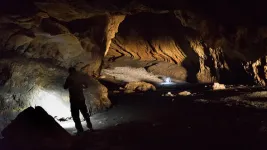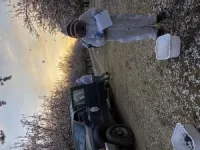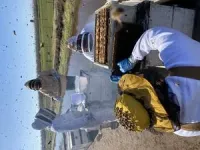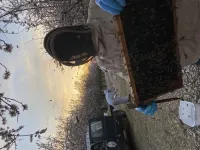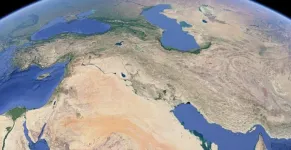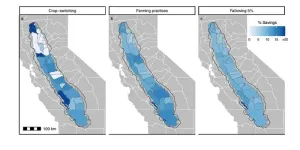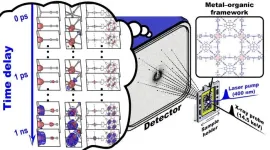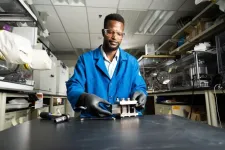(Press-News.org) A new study combining genetic, palaeoecological, and archaeological evidence has unveiled the Persian Plateau as a pivotal geographic location serving as a hub for Homo sapiens during the early stages of their migration out of Africa.
This revelation sheds new light on the complex journey of human populations, challenging previous understandings of our species' expansion into Eurasia.
The study, published in Nature Communications, highlights a crucial period between approximately 70,000 to 45,000 years ago when human populations did not uniformly spread across Eurasia, leaving a gap in our understanding of their whereabouts during this time frame.
Key findings from the research include:
The Persian plateau as a hub for early human settlement: Using a novel genetic approach combined with palaeoecological modelling, the study revealed the Persian Plateau as the region where from population waves that settled all of Eurasia originated.
This region emerged as a suitable habitat capable of supporting a larger population compared with other areas in West Asia.
Genetic resemblance in ancient and modern populations: The genetic component identified in populations from the Persian Plateau underlines its long-lasting differentiation in the area, compatible with the hub nature of the region, and is ancestral to the genetic components already known to have inhabited the Plateau.
Such a genetic signature was detected thanks to a new approach that disentangles 40,000 years of admixture and other confounding events. This genetic connection underscores the Plateau's significance as a pivotal location for early human settlement and subsequent migrations.
Study co-author Professor Michael Petraglia, Director of Griffith University’s Australian Research Centre for Human Evolution, provided a much clearer picture of these early human movements.
“Our multidisciplinary study provides a more coherent view of the ancient past, offering insights into the critical period between the Out of Africa expansion and the differentiation of Eurasian populations,” Professor Petraglia said.
“The Persian Plateau emerges as a key region, underlining the need for further archaeological explorations."
First author Leonardo Vallini of the University of Padova, Italy, said: “The discovery elucidates a 20,000 year long portion of the history of Homo sapiens outside of Africa, a timeframe during which we interacted with Neanderthal populations, and sheds light on the relationships between various Eurasian populations, providing crucial clues for understanding the demographic history of our species across Europe, East Asia, and Oceania.”
Senior author, Professor Luca Pagani added: “The revelation of the Persian Plateau as a hub for early human migration opens new doors for archaeological exploration, enriching our understanding of our species' journey across continents and highlighting this region's pivotal role in shaping human history.”
The study ‘The Persian Plateau served as Hub for Homo sapiens after the main Out of Africa dispersal’ has been published in Nature Communications.
END
Persian plateau unveiled as crucial hub for early human migration out of Africa
2024-03-25
ELSE PRESS RELEASES FROM THIS DATE:
Honey bees at risk for colony collapse from longer, warmer fall seasons
2024-03-25
PULLMAN, Wash. – The famous work ethic of honey bees might spell disaster for these busy crop pollinators as the climate warms, new research indicates.
Flying shortens the lives of bees, and worker honey bees will fly to find flowers whenever the weather is right, regardless of how much honey is already in the hive. Using climate and bee population models, researchers found that increasingly long autumns with good flying weather for bees raises the likelihood of colony collapse in the spring.
The study, published in Scientific Reports, focused on the Pacific Northwest but holds implications for hives across the U.S. The researchers ...
20,000 years of shared history on the Persian plateau
2024-03-25
All present day non African human populations are the result of subdivisions that took place after their ancestors left Africa at least 60.000 years ago. How long did it take for these separations to take place? Almost 20.000 years, during which they were all part of a single population. Where did they live for all this time? We don’t know, yet.
This is a conversation that could have taken place one year ago, now it is possible to give clearer answers to these questions thanks to the study recently published in Nature Communications (1) led by the researchers from the University ...
New UM study reveals unintended consequences of fire suppression
2024-03-25
MISSOULA – The escalation of extreme wildfires globally has prompted a critical examination of wildfire management strategies. A new study from the University of Montana reveals how fire suppression ensures that wildfires will burn under extreme conditions at high severity, exacerbating the impacts of climate change and fuel accumulation.
The study used computer simulations to show that attempting to suppress all wildfires results in fires burning with more severe ecological impacts, with accelerated increases in burned area beyond those expected from fuel accumulation or climate change.
“Fire suppression has unintended consequences,” said lead author Mark Kreider, a Ph.D. ...
Small changes can yield big savings in agricultural water use
2024-03-25
(Santa Barbara, Calif.) — While Hollywood and Silicon Valley love the limelight, California is an agricultural powerhouse, too. Agricultural products sold in the Golden State totaled $59 billion in 2022. But rising temperatures, declining precipitation and decades of over pumping may require drastic changes to farming. Legislation to address the problem could even see fields taken out of cultivation.
Fortunately, a study out of UC Santa Barbara suggests less extreme measures could help address California’s water issues. Researchers combined remote sensing, big data and machine ...
Humans pass more viruses to other animals than we catch from them
2024-03-25
Humans pass on more viruses to domestic and wild animals than we catch from them, according to a major new analysis of viral genomes by UCL researchers.
For the new paper published in Nature Ecology & Evolution, the team analysed all publicly available viral genome sequences, to reconstruct where viruses have jumped from one host to infect another vertebrate species.
Most emerging and re-emerging infectious diseases are caused by viruses circulating in animals. When these viruses cross over from animals into humans, a process known as zoonosis, they can cause disease outbreaks, epidemics and pandemics such as Ebola, flu or Covid-19. Given the enormous impact ...
Filming ultrafast molecular motions in single crystal
2024-03-25
Understanding the behavior of matter is crucial for advancing scientific fields like biology, chemistry, and materials science. X-ray crystallography has been instrumental in this pursuit, allowing scientists to determine molecular structures with precision. In traditional X-ray crystallography experiments, a single crystal is exposed to X-rays multiple times to obtain diffraction signals. This poses a problem, where the sample has its structure altered or damaged by X-ray exposure.
In recent years, advances in technology have allowed for the development of “time-resolved serial femtosecond crystallography” (TR-SFX). In serial ...
Better phosphorus use can ensure its stocks last more than 500 years and boost global food production - new evidence shows
2024-03-25
More efficient use of phosphorus could see limited stocks of the important fertiliser last more than 500 years and boost global food production to feed growing populations.
But these benefits will only happen if countries are less wasteful with how they use phosphorus, a study published today in Nature Food shows.
Around 30-40 per cent of farm soils have over-applications of phosphorus, with European and North American countries over-applying the most.
The global population is due to hit nearly 10 billion by 2050 and it is estimated that to feed ...
New all-liquid iron flow battery for grid energy storage
2024-03-25
RICHLAND, Wash.— A commonplace chemical used in water treatment facilities has been repurposed for large-scale energy storage in a new battery design by researchers at the Department of Energy’s Pacific Northwest National Laboratory. The design provides a pathway to a safe, economical, water-based, flow battery made with Earth-abundant materials. It provides another pathway in the quest to incorporate intermittent energy sources such as wind and solar energy into the nation’s electric grid.
The researchers report ...
Gene discovery offers new hope for people living with chronic skin disease
2024-03-25
Scientists from The Australian National University (ANU) have discovered a gene mutation is responsible for causing psoriasis – a chronic inflammatory skin disease that causes patients to develop red, scaly and itchy patches across their body.
According to ANU researcher Dr Chelisa Cardinez, if two copies of this mutated gene (known as IKBKB) are present, patients with psoriasis may go on to develop psoriatic arthritis, leaving them with joint pain, stiffness and swelling. Thanks to the world-first discovery from ANU, scientists now know what causes the progression from a skin-only disease to a skin and joint disease.
It’s hoped the findings will lead ...
What factors contribute to differences in cervical cancer screening in rural and urban community health centers?
2024-03-25
In the United States, community health centers (CHCs) mainly serve historically marginalized populations. New research reveals that both before and during the COVID-19 pandemic, females receiving care at rural CHCs were less likely to be up to date with cervical cancer screening than those in urban CHCs. Factors associated with these differences included the proportion of patients with limited English proficiency and low income, as well as area-level unemployment and primary care physician density. The findings are ...
